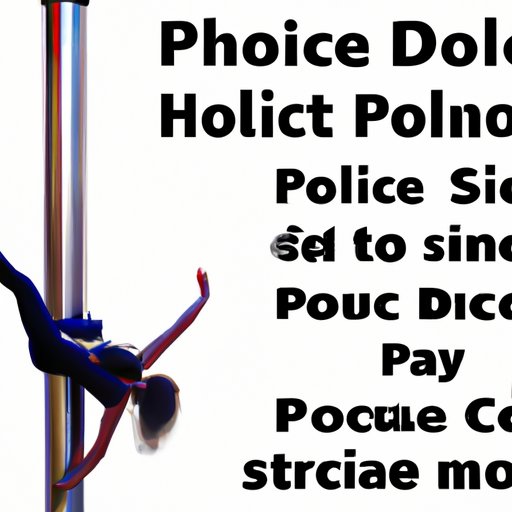Introduction
Pole dancing has become increasingly popular over the past few decades, with more and more people taking up the activity for its fitness and confidence-building benefits. But is pole dancing bad? That’s a question that many people have been asking, and it’s one that divides opinion. In this article, we’ll explore the pros and cons of pole dancing to help you decide whether it’s right for you.
But first, let’s define what pole dancing is. Pole dancing is an acrobatic art form that uses a vertical pole as a prop or support. It combines elements of dance, gymnastics and circus arts, and can be performed in a variety of styles such as exotic, freestyle and classical. Pole dancing has become a popular form of exercise, with studios offering classes for both beginners and experienced dancers.

Examining the Health Benefits and Risks of Pole Dancing
So what are the potential health benefits and risks of pole dancing? Let’s take a look.
Potential Physical Benefits
Pole dancing offers plenty of physical benefits. It builds strength and flexibility, while improving balance and coordination. It can also help to tone and shape the body, as it works muscles in the arms, legs, back, abdomen and even the glutes. And because it’s an aerobic exercise, it can help to improve cardiovascular fitness.
Potential Mental Health Benefits
Pole dancing isn’t just good for the body – it’s also great for the mind. It can help to boost self-confidence, reduce stress and anxiety, and promote feelings of empowerment. Many pole dancers report feeling more energised, positive and motivated after their classes.
Potential Risks of Injury
As with any physical activity, there is a risk of injury when pole dancing. Common injuries include strains, sprains and bruises, as well as more serious injuries such as fractures and dislocations. To minimise the risk of injury, it’s important to warm up properly before pole dancing and to use correct technique. It’s also important to listen to your body and stop if you feel any pain or discomfort.
Debunking the Myths About Pole Dancing: Separating Fact from Fiction
There are many misconceptions about pole dancing, so let’s take a look at some of these and separate fact from fiction.
Common Misconceptions About Pole Dancing
One of the most common misconceptions about pole dancing is that it’s only for women. However, pole dancing is open to everyone regardless of gender. Another misconception is that it’s only for those who are already fit and flexible – but in reality, anyone can learn how to pole dance, regardless of their fitness level.
Investigating the Reality of Pole Dancing
It’s also important to remember that pole dancing is not necessarily sexual in nature. Sure, it can be used as a form of sensual expression, but it doesn’t have to be. Pole dancing is a legitimate form of exercise and art, and it should be respected as such.
How Pole Dancing Can Improve Your Fitness and Self-Confidence
Now that we’ve debunked some of the myths about pole dancing, let’s take a look at the real benefits it can bring.
Physical Benefits of Pole Dancing
As we’ve already discussed, pole dancing can help to improve your physical fitness. It can build strength, improve flexibility and balance, and help to tone and shape the body. It can also help to improve cardiovascular fitness, as it’s an aerobic exercise.
Mental Benefits of Pole Dancing
Pole dancing can also bring plenty of mental benefits. It can help to boost self-confidence and reduce stress and anxiety. It can also promote feelings of empowerment, as it requires focus and determination. Many pole dancers report feeling more energised, positive and motivated after their classes.
Exploring the Cultural Impact of Pole Dancing: What Does it Represent?
Finally, let’s take a look at the cultural impact of pole dancing. What does it represent?
History of Pole Dancing
Pole dancing has its roots in ancient Chinese acrobatics, which were popular in the 18th century. Over the years, pole dancing has evolved into a form of artistic expression, with dancers combining elements of dance, gymnastics and circus arts. It has become increasingly popular in recent years, with more and more people taking up the activity for its fitness and confidence-building benefits.
Popularity of Pole Dancing Today
Today, pole dancing is popular all over the world. There are pole dancing competitions, festivals and workshops, and it’s now accepted as a legitimate form of exercise and art. It’s no longer seen as something that’s only done in strip clubs – instead, it’s seen as a form of self-expression and a way to get fit and stay healthy.
Meaning Behind Pole Dancing
For many pole dancers, the activity is more than just a form of exercise – it’s an outlet for creativity and self-expression. It can be a powerful tool for building self-confidence and creating a sense of community. It can also be a way to explore sensuality and sexuality in a safe and supportive environment.
Conclusion
Pole dancing is an increasingly popular activity, and it offers plenty of physical and mental health benefits. It can help to build strength and flexibility, while also boosting self-confidence and reducing stress and anxiety. It’s also a legitimate form of art and exercise, and it can be a powerful tool for self-expression and exploration. So is pole dancing bad? Ultimately, the answer is up to you.
(Note: Is this article not meeting your expectations? Do you have knowledge or insights to share? Unlock new opportunities and expand your reach by joining our authors team. Click Registration to join us and share your expertise with our readers.)
